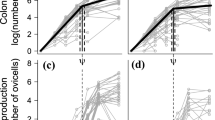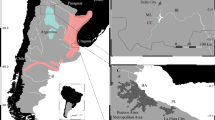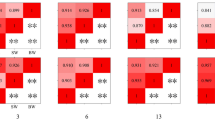Abstract
The existence of an allometric relationship between mortality rates and body mass has been theorized and extensively documented across taxa. Within species, however, the allometry between mortality rates and body mass has received substantially less attention and the consistency of such scaling patterns at the intra-specific level is controversial. We reviewed 73 experimental studies to examine the relationship between mortality rates and body size among seven species of abalone (Haliotis spp.), a marine herbivorous mollusk. Both in the field and in the laboratory, log-transformed mortality rates were negatively correlated with log-transformed individual body mass for all species considered, with allometric exponents remarkably similar among species. This regular pattern confirms previous findings that juvenile abalones suffer higher mortality rates than adult individuals. Field mortality rates were higher overall than those measured in the laboratory, and the relationship between mortality and body mass tended to be steeper in field than in laboratory conditions for all species considered. These results suggest that in the natural environment, additional mortality factors, especially linked to predation, could significantly contribute to mortality, particularly at small body sizes. On the other hand, the consistent allometry of mortality rates versus body mass in laboratory conditions suggests that other sources of mortality, beside predation, are size-dependent in abalone.


Similar content being viewed by others
References
Berg CJ, Alatalo P (1985) Biology of the tropical bivalve Asaphis deflorata (Linne, 1758). Bull Mar Sci 37:827–838
Bevacqua D, Melià P, De Leo GA, Gatto M (2011) Intra-specific scaling of natural mortality in fish: the paradigmatic case of European eel. Oecologia 165:333–339
Blueweiss L, Fox H, Kudzma V, Nakashima D, Peters R, Sams S (1978) Relationships between body size and some life history parameters. Oecologia 37:257–272
Brown JH, Gillooly JF, Allen AP, Savage VM, West GB (2004) Toward a metabolic theory of ecology. Ecology 85:1771–1789
Byström P, Andersson J, Kiessling A, Eriksson LO (2006) Size and temperature dependent foraging capacities and metabolism: consequences for winter starvation mortality in fish. Oikos 115:43–52
Calder WA (1983) Body size, mortality and longevity. J Theor Biol 102:135–144
Charnov EL (1993) Life history invariants: some explorations of symmetry in evolutionary ecology. Oxford University Press, Oxford
Dalhoff E, Somero GN (1993) Effects of temperature on mitochondria from abalone (genus Haliotis): adaptive plasticity and its limits. J Exp Biol 185:151–168
Davies MS, Williams GA (1998) Mucus in marine molluscs. Adv Mar Biol 34:1–71
Day RW, Fleming AE (1992) The determinants and measurement of abalone growth. In: Shepherd SA, Tegner MJ, Guzmán del Próo SA (eds) Abalone of the World: biology, fisheries and culture. Fishing News, Oxford, pp 141–168
Diaz F, Rio-Portilla MA, Sierra E, Aguilar M, Re-Araujo AD (2000) Preferred temperature and critical thermal maxima of red abalone Haliotis rufescens. J Therm Biol 25:257–261
Diaz F, Re AD, Medina Z, Re G, Valdez G, Valenzuela F (2006) Thermal preference and tolerance of green abalone Haliotis fulgens (Philippi, 1845) and pink abalone Haliotis corrugata (Gray, 1828). Aquac Res 37:877–884
Dickie LM, Kerr SR, Boudreau PR (1987) Size-dependent processes underlying regularities in ecosystem processes. Ecol Monogr 57:233–250
Downs CJ, Hayes JP, Tracy CR (2008) Scaling metabolic rate with body mass and inverse body temperature: a test of the Arrhenius fractal supply model. Funct Ecol 22:239–244
Ellis AE (1988) Ontogeny of the immune system in teleost fish. In: Ellis AE (ed) Fish vaccination. Academic, London, pp 20–31
Gillooly JF, Brown JH, West JB, Savage VM, Charnov EL (2001) Effects of size and temperature on metabolic rate. Science 293:2248–2251
Gosselin LA, Qian PY (1997) Juvenile mortality in benthic marine invertebrates. Mar Ecol Prog Ser 146:265–282
Gulland JA (1987) Natural mortality and size. Mar Ecol Prog Ser 39:197–199
Guzmán del Próo SA (1992) A review of the biology of abalone and its fishery in Mexico. In: Shepherd SA, Tegner MJ, Guzmán del Próo SA (eds) Abalone of the World: biology fisheries and culture. Blackwell, Oxford, pp 341–360
Hines AH, Pearse JS (1982) Abalones, shells and sea otters: dynamics of prey populations in central California. Ecology 63:1547–1560
Hou C, Zuo W, Moses ME, Woodruff WH, Brown JH, West GB (2008) Energy uptake and allocation during ontogeny. Science 322:736–739
Hutchinson N, Davies MS, Ng JSS, Williams GA (2007) Trail following behaviour in relation to pedal mucus production in the intertidal gastropod Monodonta labio (Linnaeus). J Exp Mar Biol Ecol 349:313–322
James DS, Day RW, Shepherd SA (2007) Experimental abalone ranching on artificial reef on Port Phillip Bay, Victoria. J Shellfish Res 26:687–695
Kalinin AL, Tadeu-Rantin F, Lesner-Glass M (1993) Dependence on body size of respiratory function in Hoplias malabaricus (Teleostei, Erythinidae) during grated hypoxia. Fish Physiol Biochem 12:47–51
Kozlowski J, Weiner J (1997) Interspecific allometries are by-products of body size optimization. Am Nat 147:101–114
Leaf RT, Rogers-Bennett L, Haaker PL (2007) Spatial, temporal and size specific variation in mortality estimates of red abalone, Haliotis rufescens from mark-recapture data in California. Fish Res 83:341–350
Lorenzen K (1996) The relationship between body weight and natural mortality in juvenile and adult fish: a comparison of natural ecosystems and aquaculture. J Fish Biol 49:627–647
Lorenzen K (2000) Allometry of natural mortality as a basis for assessing optimal release size in fish-stocking programmes. Can J Fish Aquat Sci 57:2374–2381
Mangel M, Stamps J (2001) Trade-offs between growth and mortality and the maintenance of individual variation in growth. Evol Ecol Res 3:583–593
Marbà N, Duarte CM, Agustí S (2007) Allometric scaling of plant life history. Proc Nat Acad Sci USA 104:15777–15780
McCoy MW, Gillooly JF (2008) Predicting natural mortality rates of plants and animals. Ecol Lett 11:710–716
McGurk JD (1986) Natural mortality of marine pelagic fish eggs and larvae: role of spatial patchiness. Mar Ecol Prog Ser 34:227–242
McGurk MD (1996) Allometry of marine mortality of Pacific salmon. Fish Bull 94:77–88
Moses ME, Hou C, Woodruff WH, West GB, Nekola JC, Zuo W, Brown JH (2008) Revisiting a model of ontogenic growth: estimating model parameters from theory and data. Am Nat 171:632–645
Peck LS, Culley MB, Helm MM (1987) A laboratory energy budget for the ormer Haliotis tuberculata L. J Exp Mar Biol Ecol 106:103–123
Peterson I, Wroblewski JS (1984) Mortality rate of fishes in the pelagic ecosystem. Can J Fish lAquat Sci 41:1117–1120
Post JR, Evans DO (1989) Size-dependent overwinter mortality of young-of-the year yellow perch (Perca flavescens): laboratory, in situ enclosure, and field experiments. Can J Fish Aquat Sci 46:1968–1985
Prince JD, Sellers TL, Ford WB, Talbot SR (1988) Recruitment, growth, mortality and population structure in a southern Australian population of Haliotis rubra (Mollusca: Gastropoda). Mar Biol 100:75–82
Raimondi PT, Wilson CM, Ambrose RF, Engle JM, Michinton TE (2002) Continued declines of black abalone along the coast of California: are mass mortalities related to El Niño events? Mar Ecol Prog Ser 242:143–152
Savage VM, Gillooly JF, Brown JH, West GB, Charnov EL (2004) Effects of body size and temperature on population growth. Am Nat 163:429–441
Seager JR (1982) Population dynamics of the Antarctic opisthobranch Philine gibba Strebel. J Exp Mar Biol Ecol 60:163–179
Shepherd SA, Breen PA (1992) Mortality in abalone: its estimation, variability, and causes. In: Shepherd SA, Tegner MJ, Guzmán del Próo SA (eds) Abalone of the world: biology fisheries, and culture. Fishing News, Oxford, pp 276–304
Sogard SM (1997) Size-selective mortality in the juvenile stage of teleost fishes: a review. Bull Mar Sci 60:1129–1157
Taborsky B, Dieckmann U, Heino M (2003) Unexpected discontinuities in life-history evolution under size-dependent mortality. Proc R Soc Lond B 270:713–721
Tegner MJ, Butler RA (1985) The survival and mortality of seeded and native red abalones Haliotis rufescens, on the Palos Verdes Peninsula. Calif Dep Fish Game 71:150–163
Tegner MJ, DeMartini JD, Karpov KA (1992) The California red abalone fishery: a case study in complexity. In: Shepherd SA, Tegner MJ, Guzmán del Próo SA (eds) Abalone of the World: biology, fisheries, and culture. Fishing News, Oxford, pp 370–383
Tilman D, HilleRisLambers J, Harpole S, Dybzinski R, Fargione J, Clark C, Lehman C (2004) Does metabolic theory apply to community ecology? It’s a matter of scale. Ecology 85:1797–1799
West GB, Brown JH, Enquist BJ (1997) A general model for the origin of allometric scaling laws in biology. Science 276:122–126
West GB, Brown JH, Enquist BJ (2001) A general model for ontogenic growth. Nature 413:628–631
Yamahira K, Conover DO (2002) Intra- versus interspecific latitudinal variation in growth: adaptation to temperature or seasonality? Ecology 83:1252–1262
Acknowledgments
We thank Stefano Leonardi, Luca Bolzoni and Simone Vincenzi for helpful comments on statistical analysis and presentation of results and Marc Mangel and Ashley Greenley for editorial advice. We are also grateful to three anonymous referees for useful comments on the manuscript draft. This work was supported through funds from the Walton Family Foundation and from the Italian Ministry of Research (PRIN project 2008 and Interlink project # II04CE49G8).
Author information
Authors and Affiliations
Corresponding author
Additional information
Communicated by Marc Mangel.
Electronic supplementary material
Below is the link to the electronic supplementary material.
Rights and permissions
About this article
Cite this article
Rossetto, M., De Leo, G.A., Bevacqua, D. et al. Allometric scaling of mortality rates with body mass in abalones. Oecologia 168, 989–996 (2012). https://doi.org/10.1007/s00442-011-2163-1
Received:
Accepted:
Published:
Issue Date:
DOI: https://doi.org/10.1007/s00442-011-2163-1




